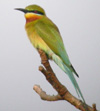
Real Birder
 |
Real Birder |
||||
| |
Hungary 19th to 26th May 2000 |
|
In December 1999 we decided to take our first organised birdwatching trip and chose Hungary, travelling with BIRDING, the company formerly run by John & Robbie Gooders. With hindsight this was a wise decision. Very few people spoke English, road signs were confusing or non-existant at times and maps were not easy to read, even for our guide who had lived there for 15 years. RESEARCH AND BACKGROUND READING
TRAVEL AND ACCOMMODATION
We were met at Ferihegy Airport by Gerard Gorman who was to be our guide for the trip, along with 2 local experts. Gerard has been living and working in Hungary since 1985 and is one of Eastern Europe's leading birders. Our return journey on 26th May left Budapest at 18.20hrs, arriving LHR 19.55hrs and giving us the opportunity to spend some time in Budapest. The Tengerszem Hotel was a little Spartan but scrupulously clean with attentive staff and a good local menu. The hotel is set at the head of a heavily forested valley and, all in all, provided a very comfortable location ideally placed to tour the Aggtelek area. It appears the same remains true to date (6/07).
In view of the early departure from London and the need for car parking facilities, we stayed overnight at The Comfort Inn Hotel, near the airport with the room costing £79, car parking £28 (7 nights @ £4 per day) and transfers to Heathrow at £3.50 per person. The “Birding” trip cost £870 per person for travel, accommodation, all meals and services of leader plus local guides. Although it was very convenient to have everything laid on in one complete package we have subsequently never used a birding holiday company preferring to have more control over the food, accommodation, company and pace of birding. AREAS VISITEDAggtelek National Park
Hortobagy National Park The Hortobagy covers an area of 80,000 ha and was established in January 1973. This area, almost due east of Budapest and in the north of the Great Plain, is much more than an empty grassland: in addition to extensive natron pastures, there are also numerous large fish ponds and c40% of the area is marshland. The apparently barren, scorched 'puszta' (grassland) is home to many birds, whilst the marshes and old reedbeds provide ideal roosting and feeding sites for numerous nesting and migrant birds. The fish ponds provide an ideal habitat and food supply for waders and other waterbirds. BIRDING HIGHLIGHTSFor us, the potential for Western Palaearctic lifers was mouth-watering and although we had a few minor disappointments, by and large we were well satisfied with the birds Gerard was able to locate for us.
Moving on to the Hortobagy we had not really been prepared for the amazing number and variety of species we would find in this bird rich area. Lifers came thick and fast with a lone Red-breasted Goose remaining with a flock of Greylag, an immaculate male Red-crested Pochard plus several Ferruginous Duck on the fish ponds along with the numerous other waterbird species and a soaring Long-legged Buzzard which we were able to scope to confirm identity. Saker were found at their nest sites on electricity pylons and Whiskered Tern graced virtually every stretch of open water along with hundreds of accompanying marsh terns. A pair of Syrian Woodpecker was nesting in the sparse woodland near the hotel and on one of our early morning walks we found a splendid Icterine Warbler nearby – didn't even need Gerard for this one! A singing Savi's Warbler was eventually located, as were two calling Aquatic Warbler, although the views of the latter were far from satisfactory. We found another nest-building Penduline Tit and whilst watching the spectacle of numerous species overflying the marshes from a raised bank, we had an all-to-brief fly-by of a small flock of 7 early Rosy Starlings.
Despite the dire accommodation on the Hortobagy we had an enjoyable trip with 149 species seen and a further 7 only heard. We had 18 lifers and would have had another if we had been able to pin down the elusive Corncrake. An added bonus was meeting Pat and Judy Hayes on the trip. We have remained friends ever since and shared many memorable birding holidays around the world. Hungary Map - Districts, National Parks etc Hungary Map - Cities and towns Bird Species List plus Excel version Hungary Bird Species Checklist
David and Amanda Mason |
| ©2012 Real Birder | Home • Photos • Trip Reports• Links • Contact Us |